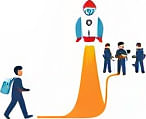Transitioning from Freelance Work to SaaS Startup Building
 by Verner Mayer
by Verner Mayer
Discover the path from independent freelancing to creating a scalable SaaS business. This guide offers practical steps, motivation, and tips for freelancers aiming for entrepreneurial independence through software development.

Many freelancers start their careers by offering services on a project-by-project basis, building skills and a client base along the way. This approach allows for flexibility and immediate income, but it often leads to a desire for something more sustainable. For those in software development, shifting to a SaaS startup can provide long-term growth and autonomy.
One key advantage of this move is the potential for scalability. Unlike freelancing, where time directly limits earnings, a SaaS model lets you create a product that serves multiple users simultaneously. This means your business can grow without proportional increases in effort. Imagine developing an application that automates tasks for clients, turning your expertise into a revenue stream that operates around the clock.
To begin the transition, start with a clear vision. Identify a problem in your field that needs solving. For instance, if you have experience in web development, consider tools that streamline processes for other developers. Once you have an idea, focus on validation. Talk to potential users to gather feedback and ensure there's demand. This step helps refine your concept before investing significant resources.
Building the actual product is next. As a freelancer with technical skills, you already have a foundation in coding and design. Use frameworks and tools that speed up development, such as open-source libraries. Remember, the goal is to create a minimum viable product that demonstrates core features. Testing and iteration are crucial here, as they allow you to improve based on real user input.
Funding is another important aspect. While bootstrapping with savings from freelancing gigs can work, explore options like small grants or crowdfunding if needed. This financial planning ensures you can cover initial costs without derailing your progress.
Marketing your SaaS startup requires a shift in mindset. Instead of pitching to individual clients, you'll need strategies that reach a broader audience. Content creation, such as blog posts or social media updates, can build visibility. Additionally, networking with other entrepreneurs provides valuable insights and potential partnerships.
Challenges will arise during this process. For example, managing both freelancing commitments and startup demands can be tough. Prioritize tasks and set boundaries to maintain balance. Another issue is competition in the SaaS space, but your unique background as a freelancer gives you an edge in understanding client needs.
Key Steps for Success
To make the transition smoother, follow these outlined steps:
- Define your niche: Choose a specific area where your skills shine, like project management tools for creative teams.
- Develop prototypes: Use your existing knowledge to build and test early versions quickly.
- Secure early users: Offer beta access to gain testimonials and refine your offering.
- Establish revenue models: Decide on pricing, such as subscriptions, to ensure steady income.
- Monitor growth: Track metrics like user acquisition and retention to guide decisions.
Stories from successful transitions can inspire. A developer who once handled custom coding jobs might now run a thriving SaaS platform that automates those same tasks for thousands. This shift not only boosts income but also fosters a sense of achievement.
In practice, staying motivated is essential. Set small milestones and celebrate achievements to keep momentum. Surround yourself with supportive communities, like online forums for entrepreneurs, to share experiences and advice.
Ultimately, moving from freelancing to a SaaS startup is about leveraging your skills for greater impact. With determination and practical steps, you can achieve business growth and the independence you've sought.
This path demands effort, but the rewards of creating something lasting make it worthwhile. By focusing on your strengths and learning from each phase, you'll build a foundation for sustained success.
